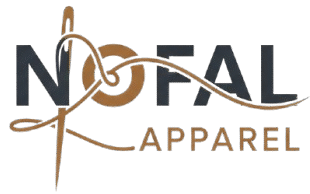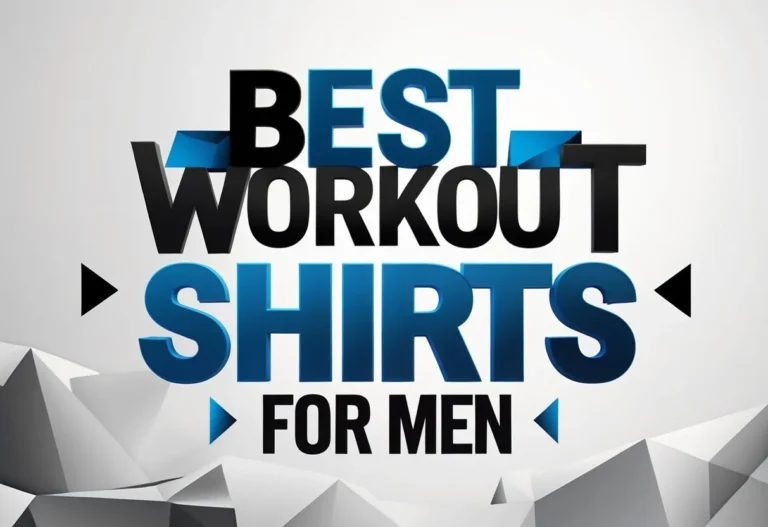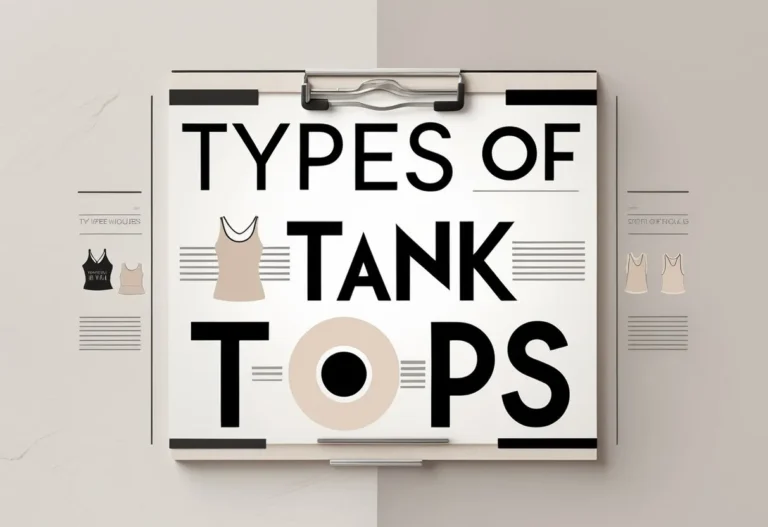How to Start a Fitness Clothing Line requires a clear plan along with understanding the market and your target audience. Many entrepreneurs succeed by focusing on designing quality, stylish gear that meets specific fitness needs, whether for yoga, running, or other activities. The key to launching a successful fitness apparel brand is combining strong research, smart planning, and effective marketing to reach the right customers.

Building the business involves more than just design—it includes setting up the right legal structure, managing production, and knowing how to price products to maintain profitability. Choosing sustainable materials and niche markets can also help new brands stand out in a competitive industry. By following a step-by-step approach, anyone can turn their passion for fitness and fashion into a viable company.
This guide will break down the essential steps needed to start and grow a fitness clothing line, ensuring clarity for those new to the field and practical advice for those ready to take action.
Key Takeways
- A clear plan and market understanding are crucial for success.
- Proper setup of legal and production processes supports growth.
- Niche focus and smart pricing help build a strong brand.
Defining Your Brand and Business Model
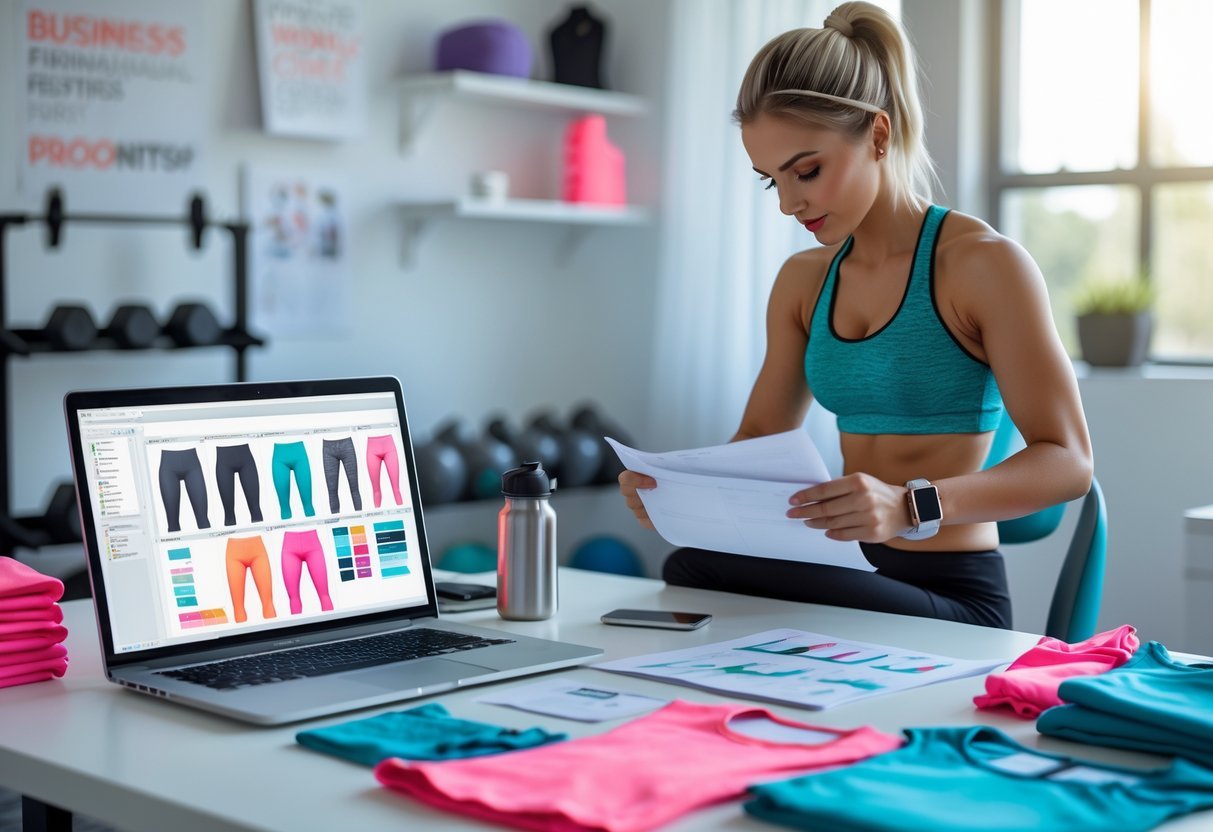
Building a fitness clothing line starts with clear decisions about who the brand serves, what sets it apart, and how it presents itself. These choices guide product design, marketing, and customer engagement to ensure the business meets specific needs and stands out in a crowded market.
Identifying Your Target Audience
The target audience shapes every aspect of a fitness brand. Knowing the exact demographics and psychographics helps tailor clothing designs and messaging. For example, many activewear brands focus on Millennials and Gen Z, who value athleisure, sustainability, and trendy styles.
It’s important to define attributes like age, gender, fitness activities, and lifestyle preferences. Women dominate the activewear market, often favoring yoga pants, sports bras, and comfort-driven apparel. Men’s fitness wear holds a smaller but growing share, with items like running gear and gym apparel rising in demand.
Understanding motivations, habits, and values allows the brand to connect more deeply. Aligning products with specific sports, such as running, yoga, or boxing, lets the business target passionate communities seeking specialized apparel.
Choosing a Unique Value Proposition
A unique value proposition (UVP) distinguishes the brand from established players like Nike or Lululemon. It answers why customers should choose this fitness line over competitors by highlighting clear benefits.
The UVP may focus on innovation, such as performance fabrics or sustainability practices. For instance, offering eco-friendly materials appeals to the growing segment willing to pay more for green products. Another UVP angle could be inclusive sizing or affordability without sacrificing quality.
Specialization is key. Targeting a specific sport or lifestyle niche—like dancewear or outdoor running gear—creates focused appeal. This helps avoid direct competition with large brands and builds loyalty by meeting unique consumer needs in underserved markets.
Developing Your Brand Identity
Brand identity is the visual and emotional expression of the business. It includes logo design, color palette, tone of voice, and the story that shapes consumer perception.
The identity should reflect the target audience’s values and the UVP. For a sustainable brand, this might mean earthy tones, simple designs, and honest messaging. A high-performance brand may use bold colors and technical imagery to communicate energy and strength.
Consistency across all channels—website, packaging, social media, and clothing tags—is essential. Strong brand identity builds recognition and trust. It helps customers feel connected to the company beyond just the product, creating a community around the fitness apparel line.
Conducting Market Analysis and Research

Understanding the fitness clothing market and your potential customers is key to building a successful brand. This involves studying industry trends, collecting data about your audience, and knowing where your competitors stand.
Analyzing Industry Trends
Fitness apparel is part of a growing $567 billion global market. Trends show that athleisure is popular, especially among Millennials and Gen Z consumers. These groups prefer sustainable and stylish activewear. Women dominate the market with about 75% of sales, mostly for sports bras, yoga pants, and tank tops.
Sustainability matters too. Studies find that 66% of buyers are willing to pay more for eco-friendly products. Brands that adopt sustainable fabrics and ethical manufacturing practices gain a competitive edge. Tracking these trends helps a new brand meet current demands and stay relevant.
Market Research Strategies
Effective market research digs into who will buy the products and what they want. This can be done through surveys, online polls, and focus groups targeting fitness enthusiasts or specific sports like yoga, running, or boxing.
Online tools also reveal buying habits through social media listening and competitor sales analysis. Identifying age, gender, lifestyle, and shopping preferences of the target market sharpens product design and marketing. Consistent research allows brands to adjust quickly as customer interests shift and new opportunities appear.
Positioning Against Competitors
In a market with giants like Nike and Lululemon, small brands must find a unique spot. This can mean focusing on niche sports, sustainable materials, or customized apparel.
Local store visits and online competitor audits show price points, branding, and customer experience styles. Signing up for competitor newsletters and observing social media campaigns reveals sales tactics and promotions. Understanding competitor weaknesses and customer needs helps new brands offer better value or unique features and build loyalty among their audience.
Crafting a Comprehensive Business Plan

A well-crafted business plan focuses on clear goals, a strong business model, and detailed planning for growth and daily operations. It helps guide decisions and shows potential investors the direction and viability of the fitness clothing line.
Executive Summary and Objectives
The executive summary is a brief but powerful overview of the fitness clothing line. It highlights the brand’s mission, key products, target market, and unique selling points, such as eco-friendly fabrics or specialized sportswear.
Clear objectives set measurable goals like launching the first collection within six months, reaching $100,000 in sales in the first year, or building a social media following of 10,000. These goals provide focus and milestones to track progress.
This section should be concise and compelling, written last but placed first in the business plan to grab attention quickly.
Business Model Selection
Choosing the right business model is critical for profitability and growth. Options include direct-to-consumer (DTC) e-commerce, wholesale to retailers, or a hybrid approach combining both.
DTC allows control over branding and higher margins but requires investment in online marketing and fulfillment. Wholesale can help scale quickly through retail partnerships but often reduces profit per item. Print-on-demand reduces upfront inventory costs but limits customization.
The chosen model must align with budget, market research insights, and long-term goals. Clear revenue streams and pricing strategies should be detailed to ensure financial viability.
Growth and Operational Planning
Growth planning outlines how the brand will scale its customer base and product line. This includes marketing campaigns, influencer partnerships, expanding collections, or entering new markets.
The operational plan covers daily functions like production schedules, inventory management, order fulfillment, and customer service. It should address suppliers, quality control, staffing needs, and software tools for tracking sales and expenses.
A solid growth and operational plan prepares the business to handle increased demand while maintaining product quality and customer satisfaction.
Financial Planning and Securing Startup Capital

Starting a fitness clothing line requires careful financial planning. This includes knowing how much money is needed upfront, estimating future earnings and costs, and finding the right sources to fund the business.
Estimating Startup Costs
Startup costs for a fitness clothing line mainly include product development, marketing, and operational expenses. Key expenses are:
- Designing and creating samples
- Sourcing or using print-on-demand services
- Website and eCommerce setup
- Branding and marketing campaigns
- Packaging and shipping supplies
- Business licenses and insurance
Using print-on-demand can reduce costs by eliminating the need for large inventory. However, it’s important to budget for marketing and product testing to ensure quality. A clear list of expected expenses helps avoid surprises and guides initial spending decisions.
Creating Financial Projections
Financial projections estimate income, expenses, and profits over time. This plan often covers the first 12-24 months and helps set realistic goals for growth and cash flow.
Projections should include:
- Sales forecasts based on market research
- Cost of goods sold (materials, manufacturing, shipping)
- Fixed expenses (rent, software subscriptions, salaries)
- Marketing and advertising budgets
- Taxes and fees
Regularly updating these projections lets the business adjust strategies based on actual performance. Clear financial forecasting is key to managing cash flow and attracting investors.
Exploring Funding Options and Investors
There are several ways to secure financing:
Self-funding: Uses personal savings, giving full control but requiring strong discipline.
Business loans: Traditional and online lenders offer loans based on creditworthiness and business plans.
Angel investors and venture capital: Provide funds in exchange for equity or debt; useful for scaling quickly.
Crowdfunding: Raises small amounts from many people, good for testing market interest.
Print-on-demand partnerships: Reduce upfront costs with low inventory needs.
Each option has pros and cons. Choosing the right funding depends on the business model, growth plans, and willingness to share ownership. Clear financial plans and projections improve chances to secure funding.
Establishing Legal Structure and Operations
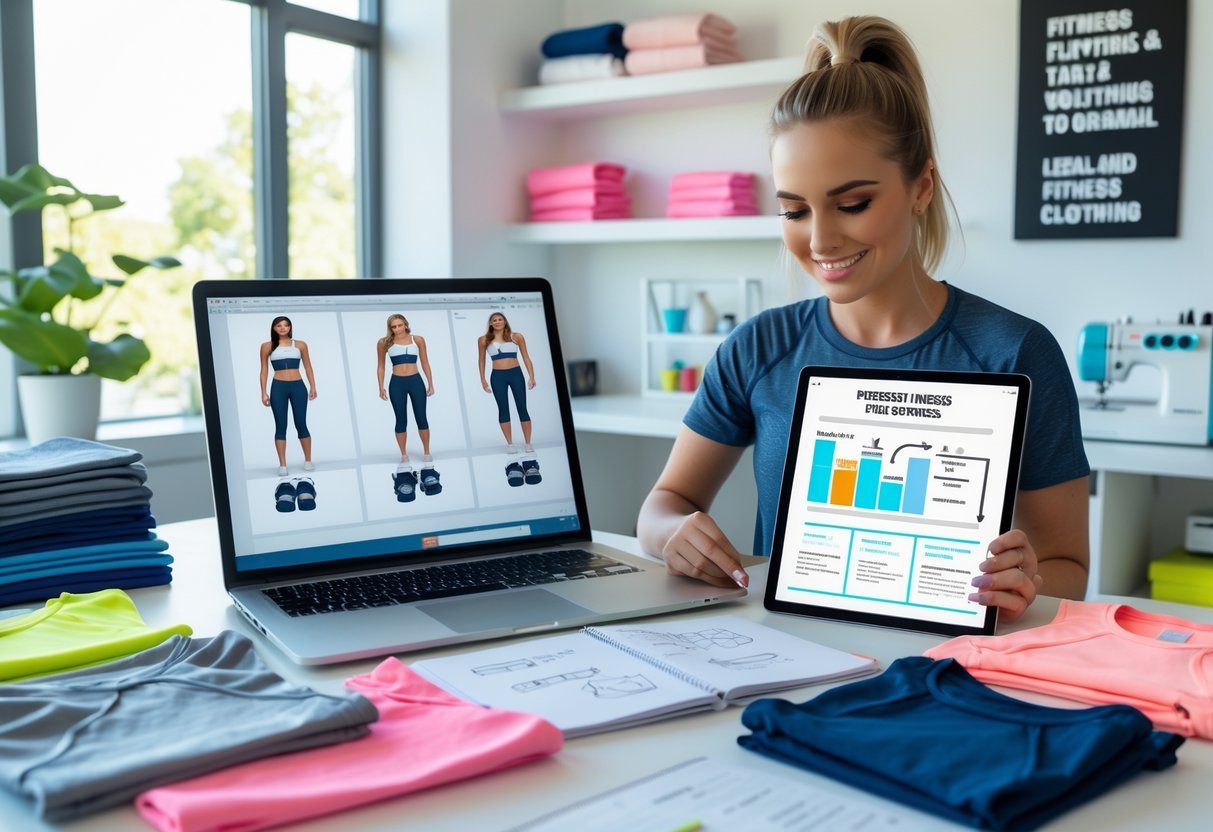
Setting up the right legal framework and operational systems is critical for a fitness clothing line. It protects the owner, ensures compliance with laws, and enables smooth sales both online and offline. Choosing the best business type, registering properly, and establishing payment methods are essential steps.
Choosing a Legal Structure
Selecting a legal structure affects taxes, liability, and management. Many small fitness clothing brands start as an LLC (Limited Liability Company) because it protects personal assets and offers pass-through taxation. This means profits and losses pass directly to the owner’s personal tax return, avoiding double taxation.
A sole proprietorship is simpler but offers no liability protection. Owners are personally responsible for business debts or lawsuits.
An S-Corporation combines liability protection like an LLC but allows some tax benefits. However, it requires stricter rules and formalities.
The choice depends on how much personal risk the owner can accept and the complexity they want in managing the business.
Registering Your Business
Registering the business legally allows it to operate and pay taxes properly. After choosing a legal structure, owners must file formation documents with their state government.
An LLC or corporation typically registers with the Secretary of State and pays filing fees. Sole proprietors might only need a local business license.
The business must also get an Employer Identification Number (EIN) from the IRS. This number works like a Social Security number for the business and is necessary for tax reporting and hiring employees.
Owners should also apply for a sales tax permit in their state to legally collect sales tax from customers.
Setting Up Payment and E-commerce Systems
A fitness clothing line selling online needs a reliable e-commerce platform and payment processing. Shopify is a popular choice because it offers easy setup, customizable stores, and built-in payment methods.
The business should accept multiple payment options like credit cards, digital wallets (Apple Pay, Google Pay), and PayPal. This increases convenience and boosts sales.
Integrating tax calculations and shipment tracking into the online store helps keep operations efficient.
Setting up a business bank account linked to the e-commerce system separates personal and business finances. This makes accounting and tax filing easier and helps build the business credit profile.
Designing, Sourcing, and Managing Production

Starting a fitness clothing line requires careful planning around product design, choosing the right materials and manufacturers, and handling inventory. Each step shapes the quality and availability of your collection and impacts your business’s success.
Developing Your Product Line
The product line should match the brand’s identity and meet customer needs. Creators often start with core items like leggings, sports bras, and performance shirts, focusing on comfort, durability, and style.
Designs must consider fabric features such as moisture-wicking, stretch, and breathability. Simple, clean aesthetics work well for versatile use, from workouts to casual wear. Using digital tools like Adobe Illustrator or Canva can streamline the process.
It helps to limit the initial range to a few products. This allows better focus on quality and reduces complexity. Testing samples early ensures the fit and fabric perform well, which helps build customer trust.
Sourcing Materials and Manufacturers
Choosing the right materials impacts product quality and customer satisfaction. Sustainable and recycled fabrics are popular and can cater to eco-conscious consumers.
Manufacturers can be local or overseas. Print-on-demand services offer no upfront costs and handle production, ideal for beginners. Traditional manufacturers require minimum orders but may offer better customization and bulk pricing.
Evaluating suppliers involves checking sample quality, turnaround times, and communication. Clear contracts should cover costs, production schedules, and returns. Building strong relationships with manufacturers is key to smooth production.
Managing Initial Inventory
Inventory management starts with deciding stock levels based on market research and anticipated demand. For new brands, keeping small quantities reduces financial risks.
Print-on-demand models eliminate inventory storage but can have longer shipping times. If holding stock, using inventory management software helps track orders and avoid overstock.
Clear return policies and easy customer service improve customer satisfaction. Monitoring sales data informs future production decisions, helping maintain balanced inventory and reduce waste.
Setting Pricing Strategy and Ensuring Profitability
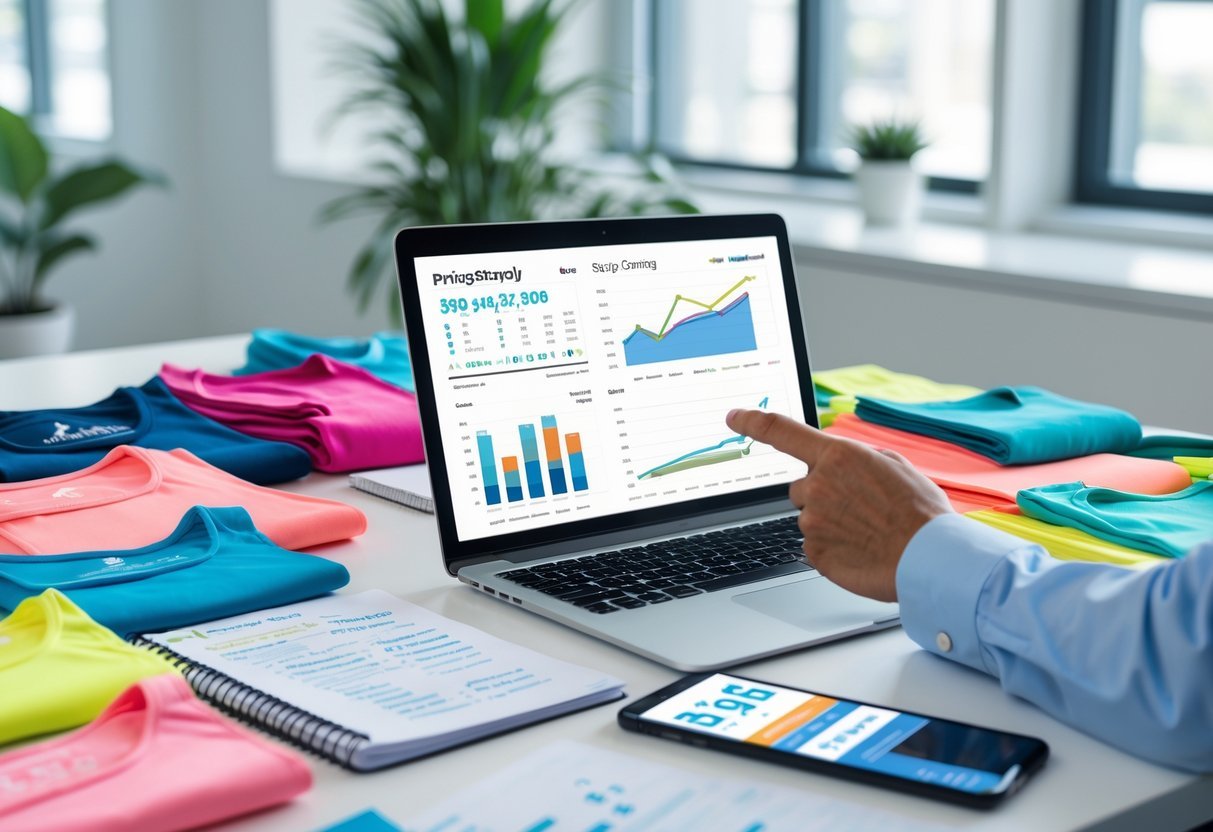
Setting the right prices is key to making the fitness clothing line sustainable and profitable. It requires a balance between what customers are willing to pay and covering all costs while making a reasonable profit. Clear steps for pricing and profit calculation help keep the business on track.
Developing Pricing Strategies
He or she should start by understanding the target market and how much they value the clothing. Pricing strategies can be based on cost-plus pricing, competitor analysis, or value-based pricing. Cost-plus adds a markup to the production cost. Competitor analysis looks at similar brands and their prices. Value-based pricing sets prices based on the perceived benefits to customers.
Offering different pricing tiers can attract a wider audience. For example, basic workout tees at a lower price and premium, performance fabrics at a higher price. Promotional offers and bundle discounts can also boost sales and customer loyalty. Keeping the pricing simple and transparent encourages trust.
Calculating Profit Margins for How to Start a Fitness Clothing Line
Profit margin shows how much money remains after covering costs. To calculate this, subtract the total cost per item (materials, labor, shipping) from the selling price. Then divide that number by the selling price and multiply by 100 to get a percentage.
For example:
| Item Price | Cost Price | Profit Margin |
|---|---|---|
| $50 | $30 | 40% |
He or she must track all expenses to avoid underpricing. A healthy profit margin in apparel usually ranges between 30% and 50%, but this depends on brand positioning and costs. Monitoring margins regularly helps in making pricing adjustments when costs or market demands change.
Launching and Growing Your Fitness Clothing Brand

Starting a fitness clothing brand requires careful attention to how the business is launched and expanded. Creating a functional online store, crafting a clear marketing strategy, and using social media effectively are key to gaining visibility and driving sales.
E-commerce Store Setup and Website Launch
Setting up an online store is the foundation for selling fitness apparel. Choosing a reliable platform like Shopify or Fourthwall allows for easy customization and smooth transactions. The website should be user-friendly, mobile-optimized, and visually aligned with the brand’s identity.
Clear product descriptions, high-quality images, and organized categories create a strong shopping experience. Integrating secure payment methods such as credit cards and Apple Pay builds customer trust. Easy navigation and a fast checkout process reduce cart abandonment.
Adding features like customer reviews and FAQs helps new buyers feel confident before purchasing. Tracking website traffic and sales data enables ongoing improvements. The store should also support promotions, discounts, and limited product drops to keep customers engaged.
Developing a Marketing Strategy for How to Start a Fitness Clothing Line
A focused marketing strategy drives brand growth by targeting the right audience with clear messaging. Understanding the customers’ needs and preferences informs product positioning and pricing.
Content marketing plays a big role. Creating workout tips, styling guides, or stories about the brand’s mission helps connect with customers on a deeper level. Email newsletters and paid ads on platforms like Google and Facebook maintain consistent outreach.
Community building strengthens brand loyalty. Collaborating with fitness influencers or local trainers expands reach and credibility. Setting measurable goals such as sales targets or follower counts allows the brand to track success and adjust tactics.
Utilizing Social Media for Brand Awareness
Social media platforms like Instagram and TikTok are essential to building awareness and engagement. Posting regular, high-quality content that shows workout apparel in use highlights the brand’s style and performance features.
Stories, Reels, and short videos get more attention and enable direct interaction with followers. Using relevant hashtags and trending challenges increases visibility. Influencer partnerships bring authentic endorsements that encourage purchases.
Responding promptly to comments and messages nurtures a loyal community. Social media ads focused on the target market increase traffic to the online store. Tracking analytics helps identify which types of content drive the most engagement and sales.
Scaling Your Business and Sustainable Growth

Growing a fitness clothing line requires strategic steps that go beyond just selling products. Key actions include diversifying what you offer and finding new ways to reach customers. Building strong partnerships also plays a vital role in expanding brand visibility and credibility.
Expanding Product Lines and Pop-Up Shops
Expanding product lines is crucial for keeping customers interested and attracting new buyers. The brand can introduce new items like accessories, shoes, or seasonal collections that match their fitness niche. Testing these products through small batches helps reduce risk and respond to customer preferences.
Pop-up shops are an effective way to increase brand exposure and connect with the local community. These temporary stores give customers a chance to see and try products in person. Pop-up shops can also support a hybrid sales model, combining online with physical presence. This approach often boosts sales and builds customer loyalty.
Building Partnerships and Influencer Collaborations
Collaborating with other brands or fitness influencers helps widen reach quickly. Partnerships with gyms, fitness studios, or wellness events can create new sales channels. Influencer collaborations, in particular, allow the business to tap into established audiences who trust those voices.
Choosing the right influencers is essential. They should align with the brand’s values and appeal to the target market. Working with micro-influencers or niche athletes often offers higher engagement and authenticity. Clear agreements about promotion and product use ensure both parties benefit. These collaborations can drive traffic, boost sales, and raise the brand profile sustainably.
Frequently Asked Questions
How to Start a Fitness Clothing Line involves careful planning, choosing the right partners, and understanding costs. Designing unique gym wear and building a strong brand identity are key to standing out. It is also important to protect the business legally to avoid issues.
What are the initial steps to establishing a fitness clothing line?
They should begin by researching the market to understand trends and competitors. Forming a legal business entity, such as an LLC, helps protect personal assets. Registering for an Employer Identification Number (EIN) and obtaining necessary licenses follow next.
How can I find and choose the right gym clothing manufacturer for my brand?
Research manufacturers that specialize in activewear and compare their quality, pricing, and minimum order quantities. Visiting factories or requesting samples will help assess product quality. It is important to select a manufacturer that aligns with the brand’s values and production needs.
What are the costs involved in launching a fitness apparel line?
Initial expenses include design and sampling, which can range from $5,000 to $15,000. Website development and marketing also require funds, with digital ad campaigns costing tens of thousands annually. Renting warehouse or retail space and purchasing equipment add to startup costs, often totaling around $100,000.
How do I design and create unique gym wear for my clothing line?
The process starts with creating sketches and tech packs that detail measurements and materials. Using sustainable or innovative fabrics can differentiate the brand. Working with designers or sampling teams ensures the final product matches the vision and fits target customers.
What are the key considerations when creating a brand identity for a fitness clothing line?
A clear logo and consistent color scheme help build recognition. Understanding the target audience, such as age, activity type, and lifestyle, guides brand tone and messaging. Incorporating sustainability or specialty sports features can add unique value.
How do I legally protect my fitness clothing brand and designs?
They should trademark the brand name and logo. Registering copyrights on original designs prevents copying. Using contracts when working with manufacturers or designers ensures ownership rights. Obtaining business insurance safeguards against liabilities.
